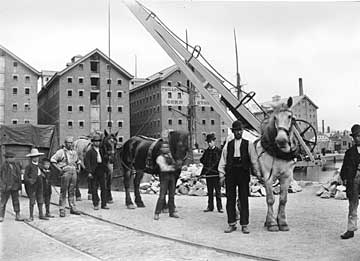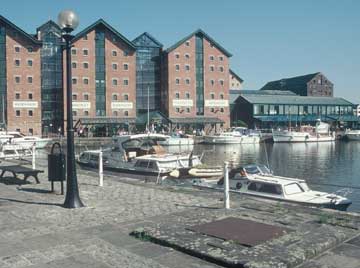Gloucester & Cheltenham Tramroad
A tramroad from Gloucester to Cheltenham was opened in 1811, and
coal and roadstone was carried by horse-drawn wagons running on
cast-iron rails mounted on stone sleeper blocks. Although the canal
was far from complete at that time, the lock at Gloucester was opened
to allow vessels to use the basin for transferring goods to tramroad
wagons. The tramroad was eventually superceded by the Midland Railway,
and the lines were taken up in 1861. For further information about
the history of the tramroad and what survives today, see study
page.
Midland Railway
After much debate and procrastination,
the Midland Railway Co. completed their branch to Bakers Quay and
the east side of the docks in 1848. Later the lines were extended
southward along the canal bank to serve the timber yards established
there. Locomotives moved wagons to and from the main line, but most
movements around the docks area were done by horses, particularly
as there were a number of turntables needed to negotiate sharp corners
around existing buildings.
Great Western Railway
The GWR completed their branch
to Llanthony Quay and the west side of the docks c1853. Initially,
this was broad gauge, but in the 1860s it was converted to mixed
gauge and a single span iron bridge was built across the canal at
Llanthony to link up with the Midland Railway lines. It had been
hoped that the GWR line would provide a ready supply of coal from
the Forest of Dean for export, but most masters preferred to load
coal at one of the South Wales ports. |

